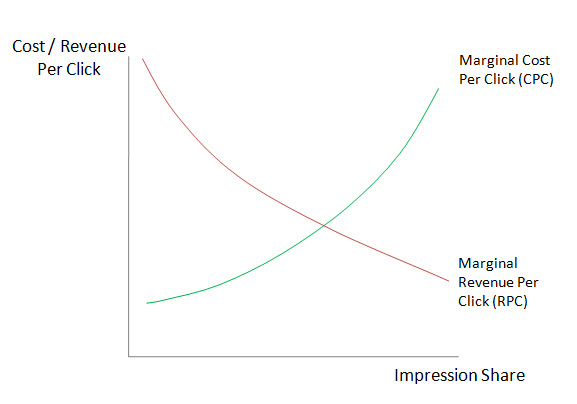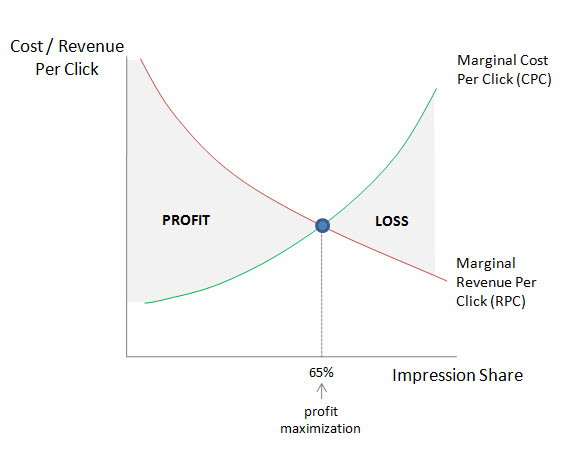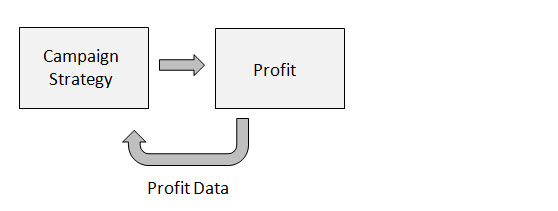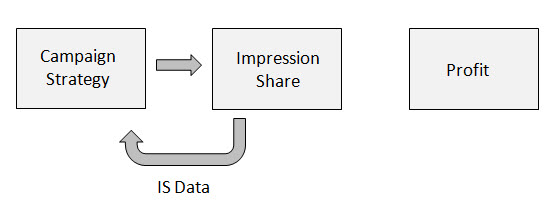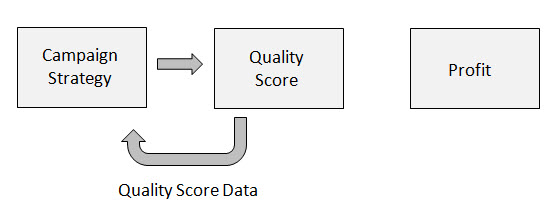Impression Share (IS) is a metric displayed in Google AdWords to describe how often your ads were shown for available searches. Does it really matter? Should you worry about a low Impression Share, or make changes to improve your Impression Share?
In short, no.
To consider why, let's look at two metrics in Google AdWords which describe how often your ads failed to show. Lost IS (budget) - the percentage of impressions you missed out on due to budget restrictions, Lost IS (rank) - the percentage of impressions you missed out on due to low Ad Rank.
Now if you are losing Impression Share due to budget, it's a no brainer. Simply increase your daily budget, and you will generally achieve more clicks for a similar average CPC. Similarly, reducing your CPC bids will generally result in more clicks for no extra spend.
It's the other part of lost impression share - Lost IS (rank) - which we're more interested in here.
Lost IS (rank) is made up of a combination of your CPC bid x Quality Score. All other things equal, increasing your CPC bids would increase your ad rank, and therefore reduce your Lost IS (rank).
Similarly, all other things equal, increasing your Quality Scores would also increase your ad rank, which would also reduce your Lost IS (rank).
This means that if your campaign is profitable, and you would like some extra visitors, then making changes to reduce your Lost IS (rank) and therefore increase your Impression Share to get extra visitors might sound like a good idea.
Wrong.
All other things are not necessarily equal. Increasing your CPC bids or making changes to improve your Quality Scores might help to increase your ad rank and increase your Impression Share, but this may be at the expense of your campaign's performance and profitability.
To see why, let's look at our two metrics which can influence Lost IS (rank) in more detail - CPCs and Quality Scores.
1. Using CPCs to Increase Impression Share
Consider the diagram below, which shows a relationship between marginal cost per click, marginal revenue per click, and Impression Share. Since we are talking about marginal costs and marginal revenue, it illustrates how costs and revenues would change as impression volume (and therefore click volume) changes.
The green line shows how the cost per click (CPC) price for each extra click would increase as Impression Share increases. Since you would arguably need to bid higher CPCs to get more impressions, and show on broader, more generic and competitive keywords, this makes sense. The more you want to increase your Impression Share, the higher each potential click will cost, hence the upward-sloping line.
The red line shows how revenue per click (RPC) would fall for each extra click as Impression Share is increased. Since increasing your impression share will arguably result in needing to show higher for your more generic, broader, and less profitable keywords, the downward-sloping marginal revenue line makes sense. If you want more volume, each extra click is likely to deliver you less revenue.
For each click where your marginal revenue is higher than your marginal cost, you are making extra profit. For each click where your costs are higher than your revenue, you are making a marginal loss.
The point of profit maximisation is therefore where your marginal cost are equal to your marginal revenue (highlighted by the blue dot). This is at an impression share of 65%. When the revenue for an extra click is greater than your costs for that extra click (i.e. anywhere to the left of 65% Impression Share), increasing your CPCs to increase your Impression Share would be a wide move, as it would increase overall profit.
When costs for extra clicks is higher than the revenue those extra clicks generate (i.e. anywhere to the right of the blue dot), you are making a marginal loss, so reducing your CPC bids and reducing your Impression Share would increase your overall profits.
The point of profit maximisation is therefore where Impression Share is at 65%. Any less than 65%, then increasing your CPC bids would increase your profits. Any higher than 65%, then reducing your CPC bids would increase your profits.
To determine your point of profit maximisation, you will need to tweak your CPC bids, measure the effect, and adjust accordingly. This is known as keyword bid optimisation. Your campaign strategy has the primary objective to increase profits, and data about profits is fed back to you for further optimisations.
Notice how Impression Share isn't present in the above relationship. This is because Impression Share is not needed in order for you to maximise profits. If increasing Impression Share is your objective, (see below), maximising profit becomes your secondary objective. It is not longer directly linked to your campaign strategy, and control is lost over the profits of the campaign. You might achieve higher Impression Shares, but what about profit?
2. Using Quality Scores to Increase Impression Share
Similarly, if your campaign strategy was simply to maximise your Quality Scores, then you probably will achieve higher Quality Scores, and also probably achieve higher Impression Shares. But what good has this achieved if higher Quality Scores and higher Impression Shares do not translate into higher profits? Remember:
- Quality Scores don't actually sell anything.
- Impression Shares don't actually sell anything.
If your campaign strategy is focused around a secondary objective such as increasing Quality Scores, then you have once again disconnected with your primary goal of maximising profits from your campaigns (see below).
For example, to boost your Impression Share via the Quality Scores method, you could simply look to create some over-enticing ad messages and achieve an extremely high CTR (one of the key components of Quality Score). This will likely result in a high CTR, high Quality Score, and high Impression Share, and will likely deliver a many more visitors to your website.
But if these visitors are unqualified, poorly-targeted, and poorly-engaged, your profitability will be terrible.
Conclusion
Google provides all sorts of metrics and indicators for your campaigns:
- Impression Share
- Quality Score
- First Page Estimate
- Low Search Volume
- Top vs. Side Placement
If the ultimate goal of your campaigns is to increase your Impression Share, boost your Quality Scores, increase your first page visibility, or maximise your number of top vs. side placements, then go ahead, make changes to your campaigns to achieve these goals, and you'll likely notice a positive change in these metrics.
But if instead, your ultimate goal is to maximise the profitability of your campaigns, these secondary metrics and indicators should be taken with a pinch of salt.
The bottom line is that if you create a highly-relevant, targeted, long-tail strategy from the bottom-up, and optimise your campaigns with the primary focus to maximise profit, then it does not matter whether you achieve Quality Scores of 5 or Quality Scores of 9.
Neither does it matter whether you've got an Impression Share of 47% or an Impression Share of 63%. All that matters is that you've maximised profits for your campaigns. All other metrics are rather meaningless.
If you liked this post, you might also enjoy 3 Practical AdWords Strategies for Mature PPC Campaigns

